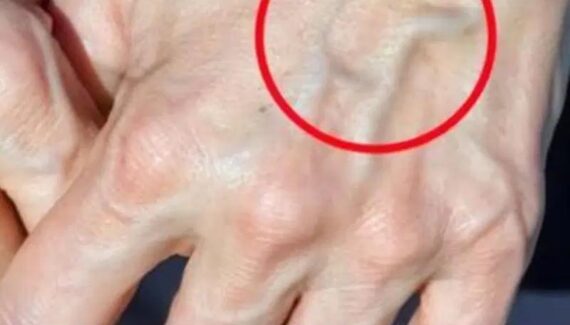
If a Tendon Raises Up When You Touch Your Pinky to Your Thumb, Here’s What It Could Mean
The human body is full of fascinating quirks, some of which can reveal interesting insights into our evolutionary past. One such oddity is a visible tendon that raises when you touch your pinky finger to your thumb. This small anatomical feature has intrigued many people, but what does it actually mean? In this article, we will explore what this raised tendon signifies, the science behind it, and how you can check for it yourself.
What Is the Raised Tendon Phenomenon?
If you place your hand palm-up on a flat surface and then touch your pinky to your thumb, you may notice a thin tendon popping up on your wrist. This tendon is part of the palmaris longus muscle, which runs from your elbow to your palm. However, not everyone has this muscle—it is completely absent in about 10-15% of the global population.
Why Does It Happen?
The palmaris longus is considered a vestigial muscle, meaning it no longer serves a crucial function in humans. It was likely more useful to our primate ancestors, who relied on strong grip strength for climbing. Today, its presence or absence does not affect hand function, although it is sometimes used in reconstructive surgery because it can be removed without causing any harm.
Step-by-Step Guide to Checking for the Raised Tendon
If you’re curious whether you have this tendon, follow these simple steps:
Step 1: Place Your Hand on a Flat Surface
- Find a smooth, flat surface like a table or desk.
- Rest your hand on it with your palm facing upward.
Step 2: Touch Your Pinky to Your Thumb
- Slowly bring your pinky finger to touch the tip of your thumb.
- This movement engages the tendons in your wrist.
Step 3: Slightly Flex Your Wrist
- Gently lift your hand off the surface while keeping your pinky and thumb touching.
- Watch your wrist carefully to see if a tendon becomes visible.
Step 4: Compare Both Hands
- Repeat the same steps with your other hand.
- You may find that the tendon is more prominent in one hand than the other, or that you have it in only one hand.
What If You Don’t Have the Tendon?
If you don’t see a raised tendon, don’t worry—it simply means you are among the percentage of people who lack the palmaris longus muscle. Its absence does not impact grip strength or dexterity in any way.
The Role of the Palmaris Longus in Medicine
Though the palmaris longus muscle is not essential, it has medical significance. Because it is not crucial for normal hand function, surgeons often use it in tendon graft procedures. It can be removed and repurposed for reconstructive surgery, such as repairing damaged ligaments in the hand or forearm.
Conclusion
The raised tendon phenomenon is a simple yet intriguing example of human evolution. Whether you have the palmaris longus muscle or not, it does not affect your daily life—but it does provide an interesting insight into our biological history. Try this test for yourself and see if you have this vestigial muscle!
If a Tendon Raises Up When You Touch Your Pinky to Your Thumb, Here’s What It Could Mean
The human body is full of fascinating quirks, some of which can reveal interesting insights into our evolutionary past. One such oddity is a visible tendon that raises when you touch your pinky finger to your thumb. This small anatomical feature has intrigued many people, but what does it actually mean? In this article, we will explore what this raised tendon signifies, the science behind it, and how you can check for it yourself.
What Is the Raised Tendon Phenomenon?
If you place your hand palm-up on a flat surface and then touch your pinky to your thumb, you may notice a thin tendon popping up on your wrist. This tendon is part of the palmaris longus muscle, which runs from your elbow to your palm. However, not everyone has this muscle—it is completely absent in about 10-15% of the global population.
Why Does It Happen?
The palmaris longus is considered a vestigial muscle, meaning it no longer serves a crucial function in humans. It was likely more useful to our primate ancestors, who relied on strong grip strength for climbing. Today, its presence or absence does not affect hand function, although it is sometimes used in reconstructive surgery because it can be removed without causing any harm.
Step-by-Step Guide to Checking for the Raised Tendon
If you’re curious whether you have this tendon, follow these simple steps:
Step 1: Place Your Hand on a Flat Surface
- Find a smooth, flat surface like a table or desk.
- Rest your hand on it with your palm facing upward.
Step 2: Touch Your Pinky to Your Thumb
- Slowly bring your pinky finger to touch the tip of your thumb.
- This movement engages the tendons in your wrist.
Step 3: Slightly Flex Your Wrist
- Gently lift your hand off the surface while keeping your pinky and thumb touching.
- Watch your wrist carefully to see if a tendon becomes visible.
Step 4: Compare Both Hands
- Repeat the same steps with your other hand.
- You may find that the tendon is more prominent in one hand than the other, or that you have it in only one hand.
What If You Don’t Have the Tendon?
If you don’t see a raised tendon, don’t worry—it simply means you are among the percentage of people who lack the palmaris longus muscle. Its absence does not impact grip strength or dexterity in any way.
The Role of the Palmaris Longus in Medicine
Though the palmaris longus muscle is not essential, it has medical significance. Because it is not crucial for normal hand function, surgeons often use it in tendon graft procedures. It can be removed and repurposed for reconstructive surgery, such as repairing damaged ligaments in the hand or forearm.
Conclusion
The raised tendon phenomenon is a simple yet intriguing example of human evolution. Whether you have the palmaris longus muscle or not, it does not affect your daily life—but it does provide an interesting insight into our biological history. Try this test for yourself and see if you have this vestigial muscle!
If a Tendon Raises Up When You Touch Your Pinky to Your Thumb, Here’s What It Could Mean
The human body is full of fascinating quirks, some of which can reveal interesting insights into our evolutionary past. One such oddity is a visible tendon that raises when you touch your pinky finger to your thumb. This small anatomical feature has intrigued many people, but what does it actually mean? In this article, we will explore what this raised tendon signifies, the science behind it, and how you can check for it yourself.
What Is the Raised Tendon Phenomenon?
If you place your hand palm-up on a flat surface and then touch your pinky to your thumb, you may notice a thin tendon popping up on your wrist. This tendon is part of the palmaris longus muscle, which runs from your elbow to your palm. However, not everyone has this muscle—it is completely absent in about 10-15% of the global population.
Why Does It Happen?
The palmaris longus is considered a vestigial muscle, meaning it no longer serves a crucial function in humans. It was likely more useful to our primate ancestors, who relied on strong grip strength for climbing. Today, its presence or absence does not affect hand function, although it is sometimes used in reconstructive surgery because it can be removed without causing any harm.
Step-by-Step Guide to Checking for the Raised Tendon
If you’re curious whether you have this tendon, follow these simple steps:
Step 1: Place Your Hand on a Flat Surface
- Find a smooth, flat surface like a table or desk.
- Rest your hand on it with your palm facing upward.
Please Head On keep on Reading (>) for the FULL ARTICLE:









No Responses Yet